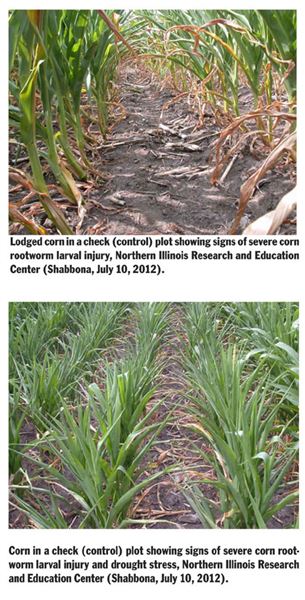Corn Rootworm Product Evaluation Trials
URBANA, ILL.
The annual University of Illinois “root digs”
have begun. Our crew, led by Ron Estes,
senior research specialist in agriculture,
and Nick Tinsley, visiting research specialist,
have dug roots from our so-called “standards” at
several of the research and education centers
around the state (near Monmouth and Perry and
just south of Urbana). Late next week, we will
evaluate the treatments – soil insecticides and
Bt hybrids – at the Northern Illinois Research
and Education Center near DeKalb.
These experiments include many familiar Bt
products and soil insecticides and are planted
on ground that was a trap crop the previous
year. The trap crop, intentionally planted late in
relation to nearby corn plots, is interplanted
with pumpkins. The late-silking corn plants and
pumpkin blossoms attract numerous egg-laying
western corn rootworm females, generally creating
a favorable environment to challenge the root
protection afforded by various corn rootworm
products.
At the July 10 field day at the Northern Illinois
Research and Education Center, I spoke to
about 125 participants, who viewed some significant
root injury to the check (control) plots
in our corn rootworm product evaluation experiment.
Western corn rootworm adults could be
found with relative ease feeding on silks and
pollen. Within the next week, the larval feeding
period should be over. Based on the degree of
root injury I observed on a few of the check
plants (2 nodes of roots destroyed), we should
have interesting and informative results to share
later this summer. On July 9 I rated the roots
from the Urbana “standard” and also found very
significant root injury in the check plots.

The importance of protecting the corn crop
from severe rootworm larval feeding should not
be underestimated. Earlier this year, Nick Tinsley
published a journal article summarizing the
impact of corn rootworm larval injury on yield
by analyzing a data set of 7,118 root ratings over
19 location years. The locations were DeKalb,
Monmouth, Perry, and Urbana from 2005 to
2011. In a given year, not every location was included.
The analysis revealed that for each node
of roots destroyed by corn rootworms, producers
should expect a yield loss of about 15 percent.
For a more complete review of this
research, see Tinsley, N.A. et al. 2012. Validation
of a nested error component model to estimate
damage caused by corn rootworm larvae.
Journal of Applied Entomology.
doi:10.1111/j.1439-0418.2012.01736.x
For fields in which drought conditions exist
and several nodes of roots have been destroyed,
yield losses caused by corn rootworms can be
very significant. No wonder such significant research
investments are made to develop products
that can be used to effectively manage this
impressive insect pest of corn. Δ
DR. MICHAEL GRAY: Professor Crop Sciences
Extension Coordinator, University of Illinois